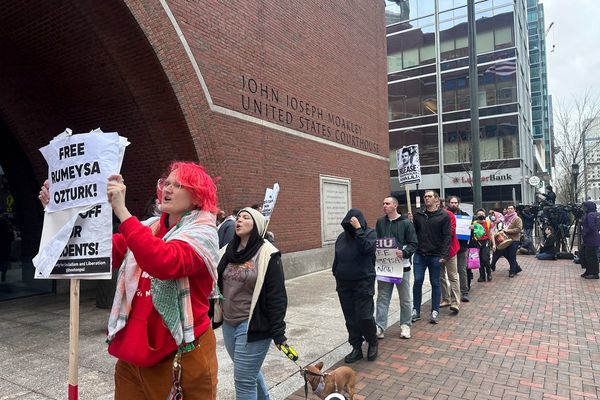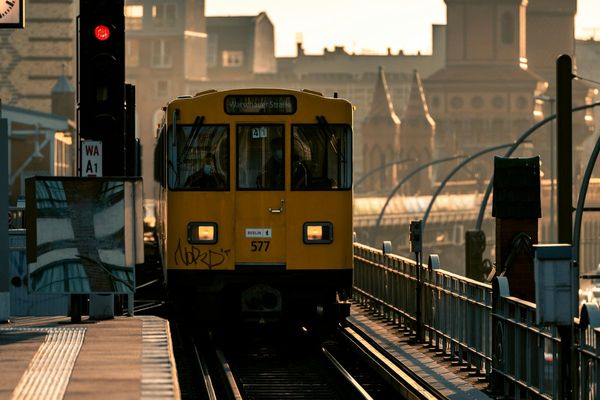
Good journeys start with loose itineraries. At Roger Robinson’s home in Northampton, by a rain-dappled window one windswept Wednesday, we pored over a large, unfolded Geographers’ A-Z of Great Britain splayed out across his kitchen table. Looking at this map, with its iconic blue/red/white colourway, we were reappropriating that old racist chant sung on British football terraces in the 1970s and 80s; there is Black in the union jack. From Hove to Hull, we had Black friends everywhere.
Roger and I had spoken about a potential collaboration for years. I lent one of my photographs to the cover of Roger’s TS Eliot prize-winning collection of poetry, A Portable Paradise. For my birthday, Roger gave me a copy of The Sweet Flypaper of Life, a collaboration between two African Americans, the poet Langston Hughes and photographer Roy DeCarava, detailing everyday life in 1950s Harlem. I often mentioned the 1970s anthology Worlds: Seven Modern Poets, in which a group of photographers follow poets through the landscapes that inspire their writing, and my admiration of John Berger and Jean Mohr’s A Seventh Man, charting the struggles of European migrants, also from the 1970s.

Model Eunice Olumide in the wind, 2021
‘I’d never taken photographs of a model before,’ writes Johny Pitts, ‘and actually am not at all interested in fashion photography, but it was fascinating working with somebody who knows their body and face so well. Her lack of ego was interesting – she wasn’t interested in me getting the most flattering image of her, but rather of us getting the most interesting image, a true collaboration. The weather, as usual, was truly awful. We went out together, near where she grew up, in a thunderstorm, hence her gusty hair.’
With the world in stasis during the coronavirus pandemic, it felt like an important time to use our respective tools to reflect upon the Black British experience. We were, after all, living in the wake of austerity, the Windrush scandal, Grenfell Tower, a rise in racist rhetoric surrounding Brexit and the 2020 Black Lives Matter protests, following the murder of George Floyd, which led to the toppling of the Colston statue in Bristol.
That this reflection should be a collaboration powered by our community was just as important. “Perhaps home is not a place,” wrote James Baldwin in his novel Giovanni’s Room, “but simply an irrevocable condition.” Baldwin’s characters were dealing with forbidden love, but the notion of home as an irrevocable condition resonates with a broader Black experience in Britain.

Photo Memories, Gillingham, 2020
‘I remember my parents using Konica film in the 80s and early 90s and a famous 1990 ad slogan: “Konica colors are calling me.” That commercial made me want to be a photographer, but I later found out it was filmed at the grave of the colonialist Cecil Rhodes. That seems such a fitting metaphor for the end of the 20th century – the corporate face of wholesome optimism, hiding something darker underneath. I really feel like we’re still living in the wake of the 20th century – its hopes and dreams, its cracks and failures. Konica has been defunct since 2007, but some of the old Konica labs still have the logo – like this one.’
When the pandemic hit the world in 2020, I was living in my dream city in the south of France, Marseille, but was dragged back to Blighty by circumstance. When it all hit the fan, I had to come back, not for love of this place, Brexit Britain, but to be close to the community I grew up with, my loved ones who I knew would take me in and offer solace in a time of crisis. Home, the irrevocable condition.
But what form should a project grappling with the bittersweet notion of being Black and British now assume? And where should we go? One possibility was to think of some of the incredible gains made throughout this politically charged era. Those in the fields that were familiar to us have achieved considerable acclaim for innovative work and people we’d struggled alongside on the periphery for years, such as Bernardine Evaristo, Jay Bernard, Warsan Shire and Raymond Antrobus, were finally gaining critical and commercial recognition.

RFC Fish & Chips, Blackpool, 2021
‘It was 11pm on a weekday night in off-season Blackpool, and Roger and I were getting hangry. We roamed the front until we found one place open which served fish and chips. As we were scoffing Roger wiped the grease off his hands and I realised I’d never noticed his tattoos before. I had to laugh when he gave me a very un-ghetto story: at a writers’ conference in Mexico City he was impressed by the art of the local tattoo culture and, after a lot of consideration, he had the names of his wife, Nicola, and son, Caden, tattooed on his hands.’
Across generations, there was, on the surface at least, a new appreciation for the contribution of Black Britons, from Caleb Azumah Nelson, who won the Costa first novel award for Open Water, to Paul Gilroy, who received the Holberg prize for his contributions to sociology and cultural studies, among other fields, and Reni Eddo-Lodge, who broke book sales records with her polemic Why I’m No Longer Talking to White People About Race.
Not to mention the many Black women artists such as Lubaina Himid, Liz Johnson Artur and Ingrid Pollard, who finally received much deserved attention from the art establishment with Turner prize nominations. It’s not that we should allow awards to define our contributions (and I will doubtless get into trouble for not naming so many more great Black British writers, artists and thinkers), but the praise suggested a flowering of Black knowledge work.
The danger with a purely celebratory project about the Black community, however, is falling into the trap of producing a predictable coffee table book full of hero shots. Those books have their place, but too often ignore the quiet contributions made by the Black community at an everyday level, those who won’t be receiving an MBE and are often on the frontline of a multicultural backlash. The Ghanaian security guard, the street sweeper from Jamaica, the Nigerian nurse helping to deliver babies through a pandemic, the Somali teacher decolonising the curriculum – all overlooked in favour of studio portraits of Lenny Henry or Frank Bruno. But Blackness, not to mention Britishness, is more complicated than that and our project demanded a more complicated form in order to reflect a Black life in Britain that can sometimes verge on the surreal.

Meshach, Blackpool, 2021
‘We met the Gordon brothers at Auntie T’s Spice Shak, around the corner from our tiny B&B. We spent the day together, four Black men, discussing our hopes for the future, and the trials and tribulations of the past. The brothers’ father had seen Blackpool as a sort of utopia, a place to retire and rest in, but died shortly after moving the family there from Lewisham. The boys had to grow up quick in their new environment, and told us that sometimes people look at them as if they’re gangsters when they’re driving. I like this photograph because it captures the calm thoughtfulness both brothers exuded.’
I began thinking of the many ways in which other travellers had made sense of the country through specific trips. In his 1980s masterpiece A1: The Great North Road, photographer Paul Graham explored the north/south divide by travelling up Britain’s central artery. On the eve of the second world war, George Orwell charted a path through industrial cities to carve out a portrait of working-class lives in The Road to Wigan Pier, guided by his network in the National Unemployed Workers’ Movement.
In the 1980s, travel writers Jonathan Raban and Paul Theroux travelled the coast in opposite directions, unaware that the other had a similar idea until an awkward meeting in Brighton; their respective books, Coasting and The Kingdom By the Sea, each tell a different version of events. Then there are the psychogeographers; Ian Nairn, Will Self, Iain Sinclair, Laura Oldfield Ford and Patrick Keiller, the last using an imagined character, Robinson, to pontificate – albeit compellingly – on London’s secret corners.

The Activist, Cop 26, Glasgow, 2021
‘On our journey, we often bumped into Extinction Rebellion protesters – first at St Ives during the G7 summit, later in Glasgow at the Cop26 Climate Change conference. They’re doing important work, but I was frequently frustrated at the lack of Black and working-class people at the protests. I saw this young woman on the very last day. There was something touching about the hand-made cardboard sign, which, in its low-techness seems so humble next to the all- conquering iPhone she’s holding. As the late scholar Mark Fisher wrote, it’s easier to imagine the end of the world than the end of capitalism.’
These offbeat journeys transfigure banal scenes into layered analyses of the interplay between history and modernity, but are usually skewed towards the capital and, like most of the other books mentioned, often told by a solo white male. The Robinson I was working with was real and British Trinidadian.
What would happen if we took all of this stuff and told a story through our eyes, using the Black experience as the prism through which to document a British journey? We were encouraged by recent interventions, such as Vron Ware’s Return of a Native, in which the author reinterprets the British countryside in a postcolonial, feminist context, and Anita Sethi’s I Belong Here, which elucidates the difficulties but also healing powers of the Pennines for a woman of colour. New light is also being shed on older works, such as photographer Vanley Burke’s Day Out series, following a Black community club’s outing to the seaside, and Ingrid Pollard’s Pastoral Interlude, which considers the Black body outside the urban context, in rural Britain.

Family, Land’s End, Cornwall, 2021
‘When I saw this family I thought, when do you ever see photographs of a Black family out together enjoying the English countryside? I loved that the writing on the woman’s trousers sort of matches the font on the sign. I’d run out of my usual film and took this with a roll of super-rare, super-expired Konica Sinbi slide film from Japan. As a precaution I took another on my iPhone. The film was dead, alas, so I ended up using the inferior iPhone shot. It’s weird, though, sometimes I kind of get off on missing a moment and including the one that didn’t work out. I’m wary of photographs that look too perfect.’
So in late winter 2021, we set off in a rented red Mini Cooper, following the coast clockwise, chasing the promise of brown skin in marine light (though thanks to our Great British weather in the end I would describe the colour palette of my images more as “kente cloth in fog”), through rain, sleet and snow. We left London and followed the River Thames east, towards Gravesend, where Pocahontas is buried, and where, just across the river at Tilbury, the Empire Windrush docked in 1948. Too often, that is where the history told about Black Britain begins and ends, but we continued, following the coast clockwise through Margate, Dover, Brighton, Southampton, Plymouth, Land’s End, Bristol, Cardiff, Liverpool, Blackpool, Belfast, Glasgow, John O’Groats, Edinburgh, Newcastle, Scarborough, Hull, Skegness, Orford Ness and Southend-on-Sea.

Photograph: Johny Pitts
Student, Gillingham, 2021
‘As well as the Black community, a lot of my photographs capture the weather in the UK. It was only later that I noticed this schoolboy’s tie blowing wildly in the breeze. In some of my work, the image is as much autobiography as it is social documentary. I remember those walks to and from school, the precariousness of the teenage years, the dreams and frustrations, and that’s what I recognised in this young man’s lonely figure.’In Blackpool, at Auntie T’s Spice Shak, we met two brothers who offered differing accounts of growing up Black at the British seaside. One brother found Blackpool too parochial, had worked at Blackpool Pleasure Beach and dreamed of one day using his skills in the leisure industry to work in a similar place in France or Florida. The younger brother loved Blackpool, thought it was quiet and peaceful, never wanted to leave and was attempting to start his own car valet business.
Here, we not only found Black people, but the history of empire and transatlantic slavery to which every Briton is tethered; stories of arrival, asylum and deportation and of that inverted, imaginative unit of history and geography between Europe, Africa, America and the Caribbean known as the Black Atlantic. We mostly travelled together but creatively we made parallel journeys – Roger would spend hours writing in whichever B&B we’d found, while I would be out making photographs, then we’d come together at the end of a long day to argue about comedy (in which Roger has terrible taste), gossip about the hip-hop rumour mill and philosophise our findings. Sometimes, on longer drives, we’d just listen to music and share stories or simply process the stories of others we’d just met.

Bianca, Margate, 2021
‘My friend Ayo bought a place in Margate a few years ago and told me that in 15 years it would be like Brighton. In many ways he was right. Whenever I visit I see changes, with radio stations, independent record stores and boutiques popping up. There is also a growing multicultural creative scene, and when I met Bianca, a banjo player, on the promenade, I knew I wanted to take her photograph. I love trying to subvert national cliches, and Bianca, with her scarf and 50s sunglasses called to mind an imagined British heyday of singers such as Vera Lynn.’
We found Black Yale university professors, award-winning jazz musicians, high-fashion models, bestselling authors, lawyers and lord mayors. We also found those street sweepers, nurses and security guards and we had our share of counterintuitive moments. Once, in South Shields, we got drenched making our way past Wilko and Poundland in Storm Arwen to find Arbeia, the Roman fort where Septimius Severus, a Roman emperor of African heritage (modern-day Libya) once lived.
In Belfast, I walked the psychic fault lines of the Troubles with the writer Tim Brannigan, a former member of the IRA whose mother had an affair with his father, a Ghanaian doctor, and in order to keep her brown baby a secret, had sent her newborn into foster care for a year before adopting him. These stories, invoked subtly through poetry and photography, reflect the diversity not just within British history, but within the Black experience itself.
The secret that all my favourite photographers have realised is that a photograph is not at all worth a thousand words, especially when the words are put together with the craftsmanship of a poet like Roger. Rather, a photograph, in my opinion, is something more like a haiku; a small amount of information contained in a tight, disciplined structure, which may conjure a thousand associations. So though narratives lurk in the images, haunt the poems, they are never entirely explained. We didn’t aim to produce a document about Black Britain, but rather of Black Britain; a pensive stroll, with Roger interpreting the stories by crafting images with his pen and me trying to make poetry with my camera.
Roger rarely attempted to explain my photographs, I didn’t try to illustrate his words. In the end, I see this work as a contribution to a wider collection all too often missing from Britain’s imaginary family album as constructed by white British documentary photographers and writers; of a Blackness that exists outside news cycles and on-trend hashtags; of the everyday humanity of the Black community in Britain.
Home Is Not a Place by Johny Pitts and Roger Robinson will be published by HarperCollins on 29 September. To support the Guardian and Observer order your copy at guardianbookshop.com. Delivery charges may apply.
An exhibition by Johny Pitts, commissioned by the Ampersand/Photoworks Fellowship, is at Graves Gallery, Sheffield Museums until 24 December, and Stills Gallery, Edinburgh, next year







